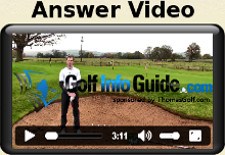You're Correct!
 The role of the back swing is to create coil, a solid base and the correct arm and club positions in order to have the ability to deliver the club in the desired manner in the down swing, with as little compensation having to be made.
The role of the back swing is to create coil, a solid base and the correct arm and club positions in order to have the ability to deliver the club in the desired manner in the down swing, with as little compensation having to be made.
The club head and body needs to be moved through a series of motions in order to take the club back on plane and up the concentric circle in order to arrive in the desired positions during the takeaway and back swing.
Here are some check points when viewing the swing from down the target line:
From a good address position, the first check point is when the club reaches parallel to the ground. The clubs shaft should match your toe line and the hands will be approximately hip height with your trail elbow remaining close to the side of the body. This position means the club head has been moved up the correct plane and in on the concentric circle. The shoulders will be turning on the tilted angle you have created by your posture, meaning the left shoulder will work down and forward while the right shoulder will work back and up (for a right handed golfer). The head should have remained in the position it was at set up and throughout the whole of the back swing.
The next check point is when the hands are parallel to the ground. As the wrists hinge and the trail elbow folds, the club shaft will be set around a 45 degree angle relative to the ground with the hands close to dissecting the trail arms bicep.
The wrists continue to hinge as the body winds up to the top of the swing. We are looking for a position where the lead arm matches the shoulder plane with the club not quite reaching parallel to the ground. The leading edge of the club should match the back of the lead arm and wrist. As the club doesnt quite reach parallel, it will look laid off, meaning the club is on plane. The shoulders will have turned 90 degrees while the hips will have turned 45 degrees.
If you can achieve these positions during the back swing you are in good shape to deliver the club in an effective manner on the down swing.
Sorry Try Again! - See Explanation Below
If the arms and club move back together in a one piece fashion, the chances are you will end up out of sync and off the desired planes. As the club starts its move off the ball, the trail arm remains close to the body and begins to fold allowing the club head to move both in and up the correct plane.
Sorry Try Again! - See Explanation Below
Trying to swing the golf club in a very linear fashion is not very powerful and also difficult to achieve biomechanically. The club head and arms travel up and in as the body turns on the tilted angles created at set up, allowing us to create effortless speed. The club swings on a concentric circle rather than in a straight back and through linear motion.
Sorry Try Again! - See Explanation Below
If the club comes back too low and too inside in the takeaway then the chances are you will have to lift the arms up off the body later in the back swing and also likely to get the club pointing across the line at the top of the back swing. Place a club on the ground parallel to the target behind your trail foots toe line. This is a check point for when the club is parallel to the ground in the back swing. Match your club shaft to the club on the ground to drill in the correct position.






